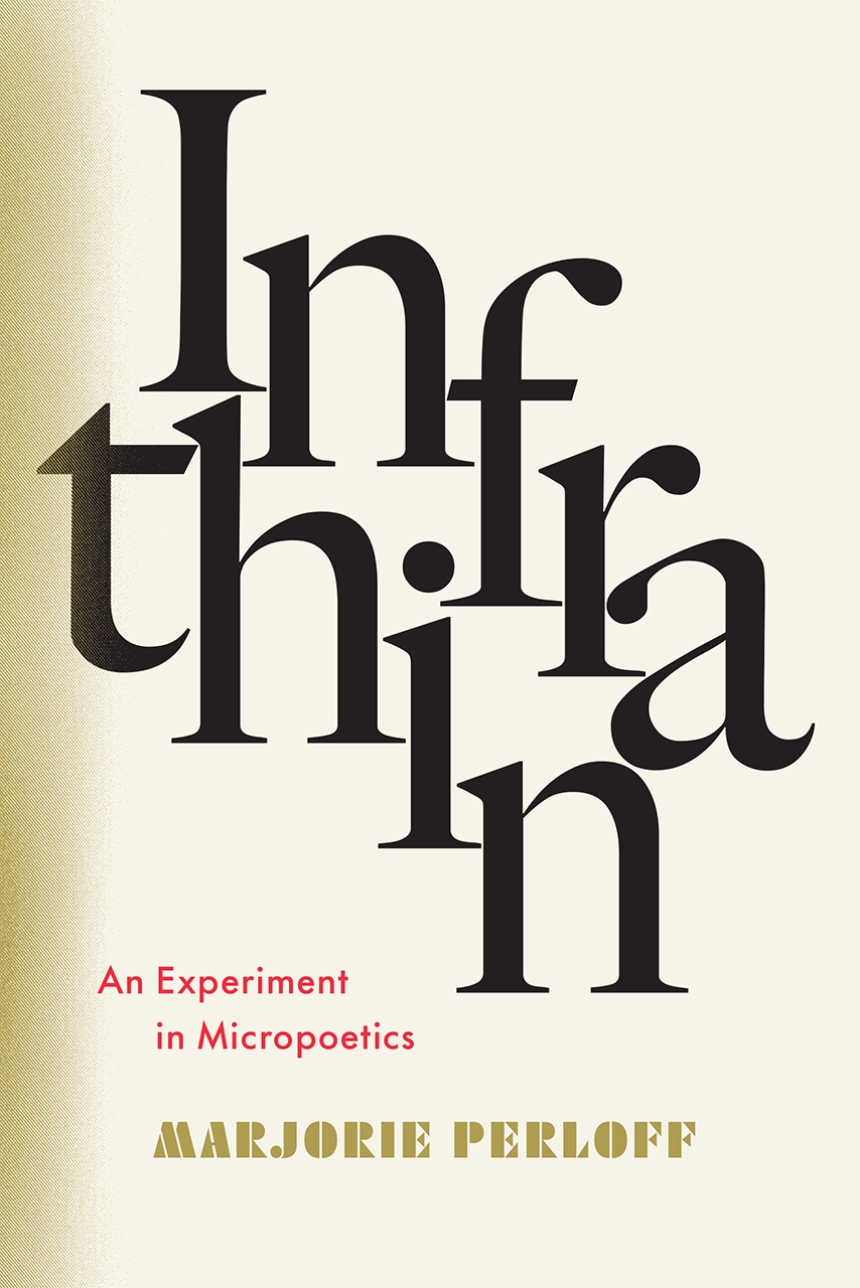Infrathin
An Experiment in Micropoetics
Esteemed literary critic Marjorie Perloff reconsiders the nature of the poetic, examining its visual, grammatical, and sound components.
The “infrathin” was Marcel Duchamp’s playful name for the most minute shade of difference: that between the report of a gunshot and the appearance of the bullet hole, or between two objects in a series made from the same mold. “Eat” is not the same thing as “ate.” The poetic, Marjorie Perloff suggests, can best be understood as the language of infrathin. For in poetry, whether in verse or prose, words and phrases that are seemingly unrelated in ordinary discourse are realigned by means of sound, visual layout, etymology, grammar, and construction so as to “make it new.”
In her revisionist “micropoetics,” Perloff draws primarily on major modernist poets from Stein and Yeats to Beckett, suggesting that the usual emphasis on what this or that poem is “about,” does not do justice to its infrathin possibilities. From Goethe’s eight-line “Wanderer’s Night Song” to Eliot’s Four Quartets, to the minimalist lyric of Rae Armantrout, Infrathin is designed to challenge our current habits of reading and to answer the central question: what is it that makes poetry poetry?
The “infrathin” was Marcel Duchamp’s playful name for the most minute shade of difference: that between the report of a gunshot and the appearance of the bullet hole, or between two objects in a series made from the same mold. “Eat” is not the same thing as “ate.” The poetic, Marjorie Perloff suggests, can best be understood as the language of infrathin. For in poetry, whether in verse or prose, words and phrases that are seemingly unrelated in ordinary discourse are realigned by means of sound, visual layout, etymology, grammar, and construction so as to “make it new.”
In her revisionist “micropoetics,” Perloff draws primarily on major modernist poets from Stein and Yeats to Beckett, suggesting that the usual emphasis on what this or that poem is “about,” does not do justice to its infrathin possibilities. From Goethe’s eight-line “Wanderer’s Night Song” to Eliot’s Four Quartets, to the minimalist lyric of Rae Armantrout, Infrathin is designed to challenge our current habits of reading and to answer the central question: what is it that makes poetry poetry?
320 pages | 15 halftones | 6 x 9 | © 2021
Literature and Literary Criticism: American and Canadian Literature, General Criticism and Critical Theory
Reviews
Table of Contents
List of Figures
Preface
A Note on Scansion and Notation
Introduction: Toward an Infrathin Reading/Writing Practice
1 “A Rose Is a Rose Is a Rrose Sélavy”: Stein, Duchamp, and the “Illegible” Portrait
2 Eliot’s Auditory Imagination: A Rehearsal for Concrete Poetry
3 Reading the Verses Backward: The Invention of Pound’s Canto Page
4 Word Frequencies and Zero Zones: Wallace Stevens’s Rock, Susan Howe’s Quarry
5 “A Wave of Detours”: From John Ashbery to Charles Bernstein and Rae Armantrout
6 The Trembling of the Veil: Poeticity in Beckett’s “Text-Soundings”
7 From Beckett to Yeats: The Paragrammatic Potential of “Traditional” Verse
Acknowledgments
Notes
Index
Preface
A Note on Scansion and Notation
Introduction: Toward an Infrathin Reading/Writing Practice
1 “A Rose Is a Rose Is a Rrose Sélavy”: Stein, Duchamp, and the “Illegible” Portrait
2 Eliot’s Auditory Imagination: A Rehearsal for Concrete Poetry
3 Reading the Verses Backward: The Invention of Pound’s Canto Page
4 Word Frequencies and Zero Zones: Wallace Stevens’s Rock, Susan Howe’s Quarry
5 “A Wave of Detours”: From John Ashbery to Charles Bernstein and Rae Armantrout
6 The Trembling of the Veil: Poeticity in Beckett’s “Text-Soundings”
7 From Beckett to Yeats: The Paragrammatic Potential of “Traditional” Verse
Acknowledgments
Notes
Index
